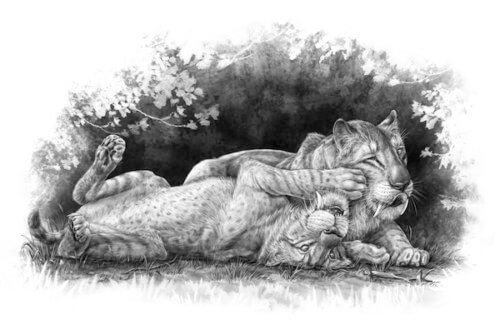TORONTO, Ontario — Millennials nowadays get a ton of flak for living with mom and dad well into their 20s. According to a new study however, living at home into adulthood is a behavior as old as time itself. Scientists at the Royal Ontario Museum (ROM) and University of Toronto say long extinct saber-toothed tigers, living during the ice age, tended to stay with their mothers for far longer than other large cat breeds. Considering how ferocious and intimidating these cats were, it’s quite interesting to learn they may have been “momma’s cubs.”
The study documents a family of saber-toothed tigers (Smilodon fatalis) whose fossils were originally discovered in the 1960s in Ecuador. After closely examining the remains, researchers came to two main conclusions. The first is that saber-toothed tigers grew at a very fast rate, reaching full size quite early in life. The second is that they seemed to stay close to their mothers well into adulthood.
“This study started out as a simple description of previously unpublished fossils,” says study leader Ashley Reynolds, a graduate student based at the Royal Ontario Museum, in a university release. “But when we noticed the two lower jaws we were working on shared a type of tooth only found in about five percent of the Smilodon fatalis population, we knew the work was about to become much more interesting.”
Saber-toothed tigers were family oriented
The first revelation motivated the team to keep investigating these prehistoric predators. This ultimately led them to the discovery that they were looking at the fossils of three separate saber-toothed tigers; a mother and two “teenaged” children. While the cubs appear to be “teenagers” in comparison to the human rate of maturation, in reality researchers estimate they were about two years-old when they passed away with their mom. That’s a major conclusion because the vast majority of big cat breeds separate themselves from their parents and begin living independently long before turning two.
Study authors also analyzed the preservation and formation of the Ecuadorian location where researchers discovered the fossils. This allowed them to conclude that the entire area, formed on an ancient coastal plain, was likely the location of a “catastrophic mass death event.” This is important to note because it means that all the creatures fossilized in this area likely died at the same time.
“The social lives of these iconic predators have been mysterious, in part because their concentration in tar seeps leaves so much room for interpretation” says study co-author Dr. Kevin Seymour, Assistant Curator of Vertebrate Paleontology at ROM. “This historic assemblage of saber-cat fossils from Ecuador was formed in a different way, allowing us to determine the two juveniles likely lived, and died, together–and were therefore probably siblings.”
“These world-famous collections made 60 years ago have been studied for years, but a measure of their importance is that they continue to produce new insights into the lives of these extinct animals” concludes Dr. David Evans, Temerty Chair of Vertebrate Palaeontology at ROM.
The study is published in iScience – Cell Press.
